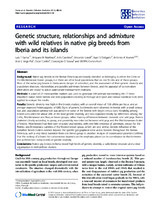Mostrar el registro sencillo del ítem
Genetic structure, relationships and admixture with wild relatives in native pig breeds from Iberia and its islands
| dc.contributor.author | Gama, Luis L.T. | |
| dc.contributor.author | Martínez Martínez, Amparo | |
| dc.contributor.author | Carolino, Inés | |
| dc.contributor.author | Landi, Vincenzo | |
| dc.contributor.author | Vicente, Antonio A. | |
| dc.contributor.author | Vega-Pla, J.L. | |
| dc.contributor.author | Cortés, Oscar | |
| dc.contributor.author | Sousa, Conceiçao O | |
| dc.contributor.author | BIOPIG Consortium | |
| dc.contributor.author | Delgado-Bermejo, J.V. | |
| dc.date.accessioned | 2013-10-15T08:57:05Z | |
| dc.date.available | 2013-10-15T08:57:05Z | |
| dc.date.issued | 2013 | |
| dc.identifier.uri | http://hdl.handle.net/10396/11110 | |
| dc.description.abstract | Background: Native pig breeds in the Iberian Peninsula are broadly classified as belonging to either the Celtic or the Mediterranean breed groups, but there are other local populations that do not fit into any of these groups. Most of the native pig breeds in Iberia are in danger of extinction, and the assessment of their genetic diversity and population structure, relationships and possible admixture between breeds, and the appraisal of conservation alternatives are crucial to adopt appropriate management strategies. Methods: A panel of 24 microsatellite markers was used to genotype 844 animals representing the 17 most important native swine breeds and wild populations existing in Portugal and Spain and various statistical tools were applied to analyze the results. Results: Genetic diversity was high in the breeds studied, with an overall mean of 13.6 alleles per locus and an average expected heterozygosity of 0.80. Signs of genetic bottlenecks were observed in breeds with a small census size, and population substructure was present in some of the breeds with larger census sizes. Variability among breeds accounted for about 20% of the total genetic diversity, and was explained mostly by differences among the Celtic, Mediterranean and Basque breed groups, rather than by differences between domestic and wild pigs. Breeds clustered closely according to group, and proximity was detected between wild pigs and the Mediterranean cluster of breeds. Most breeds had their own structure and identity, with very little evidence of admixture, except for the Retinto and Entrepelado varieties of the Mediterranean group, which are very similar. Genetic influence of the identified breed clusters extends beyond the specific geographical areas across borders throughout the Iberian Peninsula, with a very sharp transition from one breed group to another. Analysis of conservation priorities confirms that the ranking of a breed for conservation depends on the emphasis placed on its contribution to the betweenand within-breed components of genetic diversity. Conclusions: Native pig breeds in Iberia reveal high levels of genetic diversity, a solid breed structure and a clear organization in well-defined clusters. | es_ES |
| dc.format.mimetype | application/pdf | es_ES |
| dc.language.iso | eng | es_ES |
| dc.publisher | BioMed Central | es_ES |
| dc.rights | https://creativecommons.org/licenses/by-nc-nd/4.0/ | es_ES |
| dc.source | Genetics Selection Evolution 45 (2013) | es_ES |
| dc.subject | Iberian Peninsula | es_ES |
| dc.subject | Pig | es_ES |
| dc.subject | Genetic diversity | es_ES |
| dc.subject | Microsatellites | es_ES |
| dc.title | Genetic structure, relationships and admixture with wild relatives in native pig breeds from Iberia and its islands | es_ES |
| dc.type | info:eu-repo/semantics/article | es_ES |
| dc.rights.accessRights | info:eu-repo/semantics/openAccess | es_ES |

